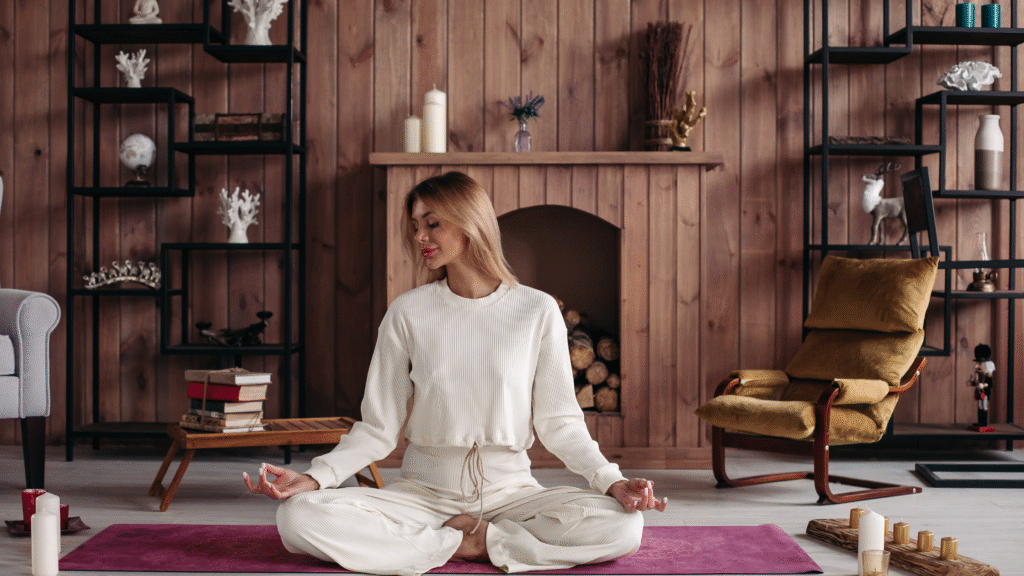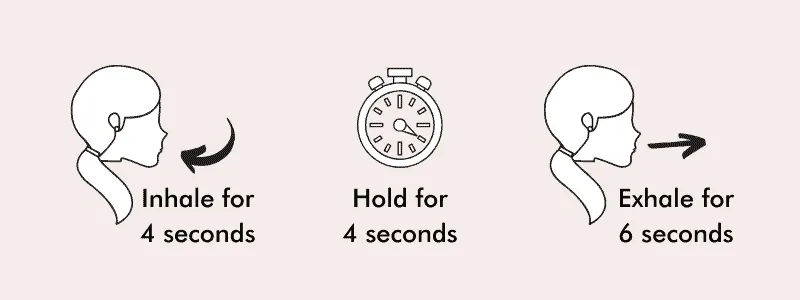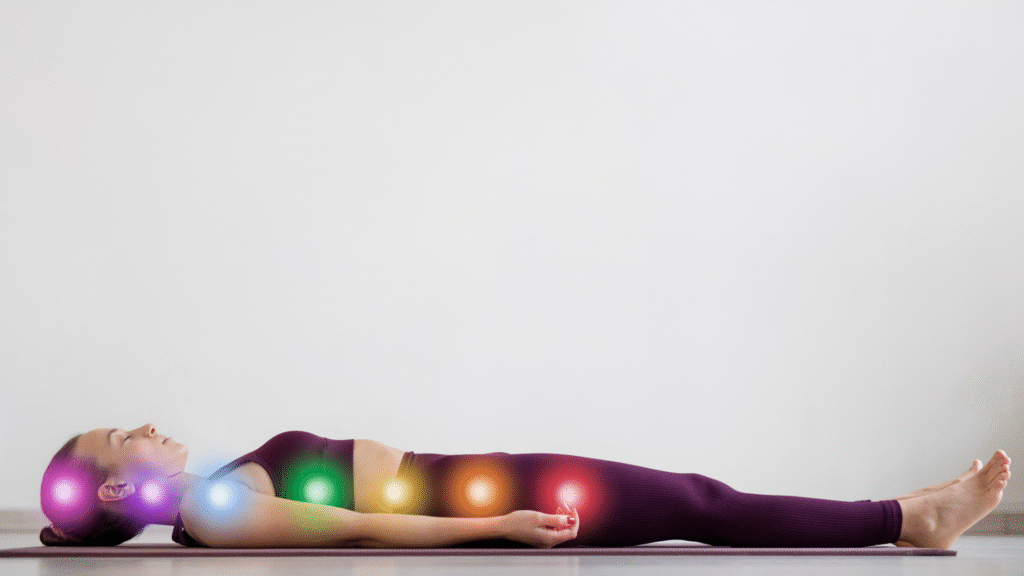Anxiety: it’s the red-eyed monster that comes sneaking into bed at 3 a.m. or the tightening in your chest before a big presentation. Even if you’re not clinically anxious (which, chances are, you are), you’ve felt it. All of us have. Hey, being a person in a world that runs on coffee, broken sleep, and doom scrolling? Crazy if you’re not anxious, right?
Here’s a fun fact: over 40 million adults in the US have anxiety disorders. That’s just the people who say something to someone. If you asked around the silent suffering, the numbers would break your heart.
One day a friend of mine said to me, “I wake up exhausted, not by my body but my brain. Every day I just feel so tired.” Something about that broke me inside. Because, yes. Same. I made her a recommendation: meditation for anxiety. She gave me the, Are you kidding me? look. (Kids, I see it in you all the time.) Then a week later, after sitting with nothing more than a few deep breaths and a couple of guided audios, she texted me, “I feel…different. Lighter? Don’t know how else to explain it.” Said meditation didn’t fix her or make her some zen goddess. It just bought her a little space.
Space. That’s what this guide is about, giving you 8 practical, actionable steps to grab a few minutes of space back in a loud, fast, emotionally bipolar world. It won’t turn you into a Himalayan hermit. But you will learn a few things about meditation and mindfulness that you can start using, today. (You don’t even need incense or some high faulting name for the posture in which you sit). You just have to be willing to show up.
Why Meditation Helps (a.k.a. The Science-y Bit That’s Actually Cool)
The thing about anxiety is that it’s like it’s turned the panic button in your brain on full blast. Your amygdala, your fight-or-flight center, is screaming DANGER! DANGER! all the time. Except the danger isn’t an oncoming car, it’s an unread Slack message or your boss’s unusual tone of voice.
Mindfulness and anxiety have this really weird but strong connection. The more mindful you are of your thoughts (the more you’re present with them instead of trying to flee from them), the less power they seem to have over you. That’s the magic of meditation practices for anxiety: They help you train your brain to pause.
In fact, research supports that. Meditation practices for anxiety and regular mindfulness practices actually change your brain. It creates more gray matter in the parts of the brain that deal with emotion regulation, and it reduces your cortisol levels (aka the stress hormone that makes you a sleepless, coffee-guzzling monster). Science says it’s true. But also, like, people say it’s true.
Like Sarah. Sarah was an executive in a marketing firm. And before meetings with her team, she used to get these total panic spirals. And after two weeks of these daily meditation practices for anxiety, she still felt anxiety, but she also felt like she had resources inside her to be with it. “I don’t feel so taken over by my thoughts,” she said. That is a win.
Step 1: Make Yourself a “Calm Corner” (It Can Be Tiny)

Let’s be real: You’re not going to feel like meditating if you have to do it while you’re crammed into a closet with laundry baskets and yesterday’s pizza box. You need a visual prompt to tell your mind, Okay, time to slow down.”
So, designate a meditation space. It doesn’t have to be a big thing or Pinterest-worthy. It could be a pillow in your closet or a chair by the window where the morning light hits. If you want to, add a candle or plant or that picture of you smiling on the beach in that swimsuit before your life got so, um, lifey.
Ahmed, a university student, created a nook next to his study desk with a salt lamp and a cushy pillow. “If I sit for even five minutes, I can reset my mind,” he told me. It’s like telling yourself, “Take a break”, the good way.
Your space matters, particularly when you’re learning meditation techniques for anxiety that work in the long term.
Step 2: Breathe. That’s It. Just Breathe.
Meet your new favorite superpower: your breath. It’s free. It’s portable. And it’s actually kind of a badass.
When you’re in the throes of spinning out, you’re breathing shallow and quickly, your body is actually under the impression that you’re being chased by a bear. Slow it down and you’re basically like, “No, dude. Bear scare. ”
So, here’s a breathing trick: try 4-4-6 (inhale for 4, hold for 4, exhale for 6). Repeat. Repeat. Repeat again for good measure. Do this for a few minutes and you’ll start to feel things level out. A little bit. Just a little bit? Hell yeah. That’s victory.

This is one of the easiest mindfulness exercises for anxiety, and the best part? You can do it anywhere. Sitting in traffic. Hurrying to the bathroom at work. Hanging over the send button of a terrifying email.
Breathing: wildly underrated, instantly effective, and absolutely a must for your best meditation for anxiety toolbox.
Step 3: Let Someone Guide You (Because Silence is Hard)
Trying to start meditation on your own can feel like going to a yoga class and not knowing what a downward dog is. Embarrassing. And completely frustrating. That’s where guided meditation can help.
Guided meditations talk you through every step of the process. They provide a voice to help when your monkey mind brain wants to jump in. And they don’t have to be 20 minutes or an hour long. Start with 5 to 10 minutes. No gold stars here for the longest time.
Try one of these meditation apps:
- Headspace: Think meditation meets cartoons. I love this app.
- Insight Timer: A massive app full of free meditations. Really, it’s huge.
- Calm: If you’re trying to fall asleep before the meditation even starts, this app is for you.
Priya is a mom of two young boys and a full-time therapist. She depends on a 10-minute meditation for anxiety that she listens to every morning. “It’s like brushing my teeth now,” she said. “If I miss it, my whole day feels off balance.”
Guided meditation audios for anxiety allow you to try out all kinds of meditation techniques. It’s the best way to figure out your personal style without any pressure or judgment.
Step 4: Cut Yourself Some Slack (No One’s “Good” at This)
Spoiler alert: you’ll think about tacos, your to-do list, that weird noise your fridge makes, and that time you tripped in front of your crush, all during meditation. And that’s not a failure. That’s just “being human”.
Your brain is a needy puppy. It wanders off, gets distracted, chases imaginary squirrels. All you need to do is gently bring it back. No yelling, no scolding, just, “Hey, back here”.” That’s the real practice.
One of the most under-appreciated meditation practices for anxiety is non-judgment. The less you try to win against your thoughts, the less you try to beat your brain into submission, the more you simply let the storm clouds pass without trying to chase them away. Just breathe. Just notice.
Tom is a client with severe social anxiety. For years, he hated meditation. To him, not doing it well=not doing it at all. His mind would race, he’d get frustrated, he’d quit halfway through. But over time, he had a big realization. “The point of meditation isn’t perfect focus. The point is to keep showing up even when your mind is full of cars going a million miles per hour”.
So if you sit for five minutes, and take one mindful breath? That’s doing it right. You’re building the muscle, millisecond by millisecond. That’s how real change happens.
Step 5: Build Your Calm Like a Habit (Not a Hobby)
I’ll be honest: 1 meditation session won’t transform you into Buddha. 5 minutes of meditation, on the other hand, will put you on the path. Kind of like flossing, for your brain: occasionally boring, BUT helpful over time.
Whether you’re using breathwork, visualizations or any other mindfulness technique to combat anxiety, the key is the repetition. Each little daily practice whispers to your nervous system, It’s okay. You’re safe. You can relax now. And eventually, your brain begins to trust you.
It’s not about suddenly becoming cool as a cucumber all the time, it’s about closing the gap between when you get triggered and when you feel centered again. In the beginning, you might only notice in small moments, not yelling at that one co-worker who chews so loudly you were half-serious about writing a noise complaint.
Case in point: Jenna, who used to have nightly panic attacks, her heart racing every time she turned off the lights. Out of desperation, she tried a 7-minute meditation before bed. Nothing changed at first, she says. But after a month, “I noticed I was able to go to sleep without all that mental struggle“. Now, she says, “My brain feels like an ally now, not a bully“.”
Here’s the thing. Regularity makes techniques into tools. Miss a day? Whatever. Just show up again tomorrow. Because each time you do, you’re showing your mind a new baseline: that calm is the default, not the exception.
Step 6: Mix It Up. There’s No One Right Way.
May be breathwork bores you. May be sitting still makes you itchy. Totally fair.
There are so many meditation practices for anxiety. You don’t have to stick to one flavor.
Try these:

- Body Scan: Great for tension. Just slowly tune into each body part.
- Loving-Kindness: Send good vibes to yourself and others. Surprisingly emotional.
- Walking Meditation: For those who can’t sit still.
- Visualization: Picture peaceful scenes or imaginary safe spaces.
| Technique | Description | Best For | Duration | Tools Needed |
| Mindful Breathing | Focus on inhaling and exhaling in slow, controlled rhythms | Beginners, panic attack relief | 3–10 minutes | None |
| Body Scan | Gently observe sensations from head to toe | Physical tension, stress relief | 10–20 minutes | Guided audio (optional) |
| Loving-Kindness | Send compassion to yourself and others | Emotional healing, self-esteem | 10–15 minutes | Script or audio guide |
| Walking Meditation | Focus on the act of walking mindfully | Restlessness, active minds | 10+ minutes | Quiet space to walk |
| Visualization | Imagine peaceful places or healing light | Sleep aid, anxiety reduction | 5–15 minutes | Calm space, optional music |
Zainab, who thought of herself as “mentally allergic” to silence, despised breathwork. Body scan audios, though? Life changing. “I didn’t realize how numb I’d become”, she told me. It’s now her favorite tool to wind down after work.
There’s no single right way, just the way that works for you.
Step 7: Tech That Helps (Yes, Really)
We’re so quick to blame technology for our stress, but it can be the solution, too, if used mindfully. It starts with using it to be present, instead of distracted. Set a timer for meditation. Track your streak. Journal how you feel after each session. That’s how you see patterns. That’s how you see progress. Wins.
Try:
- Insight Timer or Oak: Basic meditation timers without all the bells and whistles
- Day One or Moodnotes: Journaling to reflect is a massively underrated part of emotional hygiene
- YouTube: Search Jason Stephenson or The Mindful Movement for gentle guidance and meditations to calm anxiety
Samir assumed he only meditated a handful of days last month, until he looked at his app’s data. “I did it 23 days! What??!” That was the extra push I needed to keep showing up”.
Use your phone as a mindfulness companion, not an anxiety machine.
Step 8: Reflect. Adjust. Repeat.
Meditation is not one-size-fits-all. Something might serve you today, but feel off next week. That’s OK.
Check in with yourself and ask:
• Am I less impatient with others?
• Am I 5% less frazzled?
• Which of these anxiety meditation tips actually work for me?
Lara kept a journal after meditating and wrote, “I still feel anxiety. But I am no longer afraid of it.” Major progress!
Self-reflection helps you tailor your practice. Turn fuzzy-feeling relaxation into tangible awareness.
What kind of meditation works best for anxiety?
The best meditation for anxiety depends on you. Breathwork, guided audios, body scans, and loving-kindness are great starting points.
How long do I need to meditate daily?
5 to 10 minutes is solid. Consistency over length. Your brain needs reminders more than marathons.
I can’t sit still. Am I broken?
No. Try mindfulness activities for anxiety that involve movement—walking, yoga, or just stretching with deep breathing.
Can Meditation replace therapy or medicine?
Meditation is powerful, but it’s not a substitute for professional help. Think of it as support, like emotional cross-training.
Conclusion: Make peace with peace
You don’t need to be a zen master. You don’t need to be a mindfulness expert. You don’t need to achieve anything. You just need five minutes and a little bit of wonder.
Sit. Breathe. Feel awkward about it if you have to. It’s perfectly human.
Because peace? It isn’t some far-off place. It’s a home you create, one breath, one pause, one stunningly imperfect moment at a time.
You got this.




Pingback: 5 Simple Ways To Practice Mindfulness For Anxiety And Build A Routine You’ll Love